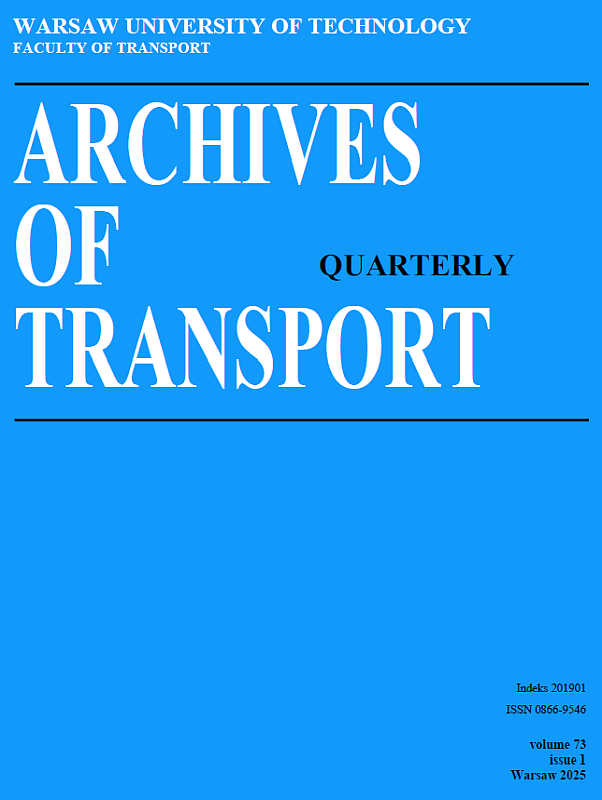The impact of container yard layout on the cargo handling time of external transport vehicles in an intermodal terminal
DOI:
https://doi.org/10.61089/aot2025.4f22k916Keywords:
intermodal transport, container terminal, yard layout, stacking strategy, crane cycle time, energy consumptionAbstract
This article investigates the impact of container yard layout on the cargo handling time of intermodal trains operating at container terminals, with a particular emphasis on the number of stacking layers used in container storage. The study focuses on how varying vertical storage configurations influence the duration of crane loading cycles as well as the energy consumption of transshipment equipment. In addition to the stacking layout, the analysis incorporates several operational constraints that are critical in intermodal rail transport, including the locking pin arrangements on railcars, container gross weights, and axle load limitations specific to intermodal wagons. The theoretical section outlines the fundamental role of intermodal terminals within global logistics and supply chains. It delves into the organization of container storage within terminal yards, highlighting its influence on handling performance and the overall turnaround time of intermodal transport units. Furthermore, the article includes a comprehensive literature review that examines state-of-the-art research on container yard storage strategies, allocation rules, and various optimization approaches aimed at improving yard efficiency. To evaluate the operational impact of different stacking strategies, a simulation model was developed using the FlexSim platform. The model allows for detailed analysis of crane cycle times in relation to stacking configurations, while also accounting for the energy usage of cranes and handling equipment. The simulations were carried out for a range of stacking scenarios to reflect real-world variability and constraints encountered in container terminals. The findings reveal that the relationship between the number of stacking layers and train loading time or energy consumption is non-linear and often counterintuitive. Increasing the number of layers does not necessarily lead to proportional gains or losses in efficiency. Instead, certain configurations may result in operational bottlenecks or increased energy use due to additional crane repositioning and container relocations. The research not only provides quantitative evidence on the operational consequences of yard design decisions but also offers practical insights for terminal planners and operators. These insights can support both short-term operational planning and long-term strategic investments aimed at optimizing terminal performance and sustainability.
References
1. Ambrosino, D., Asta, V., & Crainic, T. G. (2021). Optimization challenges and literature overview in the intermodal rail-sea terminal. Transportation Research Procedia, 52, 163–170. https://doi.org/10.1016/j.trpro.2021.01.020.
2. Borgman, B., van Asperen, E., & Dekker, R. (2010). Online rules for container stacking. OR Spectrum, 32(3), 687–716. https://doi.org/10.1007/s00291-010-0205-4.
3. Bruns, F., & Knust, S. (2012). Optimized load planning of trains in intermodal transportation. OR Spectrum, 34(3), 511–533. https://doi.org/10.1007/s00291-010-0232-1.
4. Brzeziński, M., & Pyza, D. (2021). Carbon dioxide emission from diesel engine vehicles in intermodal transport. Transport, 36(3), 246–259. https://doi.org/10.3846/transport.2021.15484.
5. Caserta, M., Schwarze, S., & Voß, S. (2012). A mathematical formulation and complexity considerations for the blocks relocation problem. European Journal of Operational Research, 219(1), 96–104. https://doi.org/10.1016/j.ejor.2011.12.039.
6. Casey, B., & Kozan, E. (2012). Optimising container storage processes at multimodal terminals. Journal of the Operational Research Society, 63(8), 1126–1142. https://doi.org/10.1057/jors.2011.113.
7. Zhou, C., Wang, W., & Li, H. (2020). Container reshuffling considered space allocation problem in container terminals. Transportation Research Part E: Logistics and Transportation Review, 136, 101882. https://doi.org/10.1016/j.tre.2020.101882.
8. Dekker, R., Voogd, P., & van Asperen, E. (2006). Advanced methods for container stacking. OR Spectrum, 28(4), 563–586. https://doi.org/10.1007/s00291-006-0038-3.
9. Komisja Europejska. (2011). Biała księga. Plan utworzenia jednolitego europejskiego obszaru transportu – dążenie do osiągnięcia konkurencyjnego i zasobooszczędnego systemu transportu. [Online]. Dostępne na: https://eur-lex.europa.eu/legal-content/PL/TXT/?uri=CELEX%3A52011DC0144.
10. Feng, Y., Song, D. P., & Li, D. (2022). Smart stacking for import containers using customer information at automated container terminals. European Journal of Operational Research, 301(2), 502–522. https://doi.org/10.1016/j.ejor.2021.10.044.
11. Fu, Z., Li, Y., Lim, A., & Rodrigues, B. (2007). Port space allocation with a time dimension. Journal of the Operational Research Society, 58(6), 797–807. https://doi.org/10.1057/palgrave.jors.2602192.
12. Gnap, J., Senko, Š., Drličiak, M., & Kostrzewski, M. (2021). Modeling of time availability of intermodal terminals. Transportation Research Procedia, 55, 442–449. https://doi.org/10.1016/j.trpro.2021.07.007.
13. Hottung, A., Tanaka, S., & Tierney, K. (2020). Deep learning assisted heuristic tree search for the container pre-marshalling problem. Computers & Operations Research, 113, 104781. https://doi.org/10.1016/j.cor.2019.104781.
14. https://obserwatorlogistyczny.pl/2024/04/05/baltic-hub-bije-kolejny-rekord-tysiace-ciezarowek-i-kontenerow-obsluzone-w-mgnieniu-oka/ (access: 28.03.2025)
15. Izdebski, M., Jacyna, M., Klimek, P., Jacyna-Gołda, I., & Vašek, R. (2019). Decision-making problems of designing database in the aspect of planning transport of cargoes by intermodal transport. MATEC Web of Conferences, 294, 04005. https://doi.org/10.1051/matecconf/201929404005.
16. Jachimowski, R., Szczepański, E., Kłodawski, M., Markowska, K., & Dąbrowski, J. (2018). Selection of a container storage strategy at the rail-road intermodal terminal as a function of minimization of the energy expenditure of transshipment devices and CO₂ emissions. Rocznik Ochrona Środowiska, 20, 965–988.
17. Ji, M., Guo, W., Zhu, H., & Yang, Y. (2015). Optimization of loading sequence and rehandling strategy for multi-quay crane operations in container terminals. Transportation Research Part E: Logistics and Transportation Review, 80, 1–19. https://doi.org/10.1016/j.tre.2015.05.004
18. Jiang, X., Chew, E. P., Lee, L. H., & Tan, K. C. (2013). Flexible space-sharing strategy for storage yard management in a transshipment hub port. OR Spectrum, 35(2), 417–439. https://doi.org/10.1007/s00291-012-0308-1
19. Kang, J., Ryu, K. R., & Kim, K. H. (2006). Deriving stacking strategies for export containers with uncertain weight information. Journal of Intelligent Manufacturing, 17(4), 399–410. https://doi.org/10.1007/s10845-005-0013-x
20. Kłodawski, M., Jachimowski, R., & Chamier-Gliszczyński, N. (2024). Analysis of the overhead crane energy consumption using different container loading strategies in urban logistics hubs. Energies, 17(5), 985. https://doi.org/10.3390/en17050985
21. Kłodawski, M., Nehring, K., Jachimowski, R., & Lipińska, J. (2024). The impact of the intermodal terminal operation strategy on container train loading duration. Transport Problems, 19(2), 163–176. https://doi.org/10.20858/tp.2023.19.2.13
22. Krześniak, M., Jacyna, M., Pryciński, P., Murawski, J., & Bańka, M. (2022). Business environment of rail transport in the context of the value chain. Zeszyty Naukowe. Transport – Politechnika Śląska, 116, 179–195. https://doi.org/10.20858/sjsutst.2022.116.11
23. Lee, D. H., Jin, J. G., & Chen, J. H. (2012). Terminal and yard allocation problem for a container transshipment hub with multiple terminals. Transportation Research Part E: Logistics and Transportation Review, 48(2), 516–528. https://doi.org/10.1016/j.tre.2011.09.004
24. Moussi, R., Euchi, J., Yassine, A., & Ndiaye, N. F. (2015). A hybrid ant colony and simulated annealing algorithm to solve the container stacking problem at seaport terminal. International Journal of Operational Research, 24(4), 399–422. https://doi.org/10.1504/IJOR.2015.069695
25. Papaioannou, V., Pietrosanti, S., Holderbaum, W., Becerra, V. M., & Mayer, R. (2017). Analysis of energy usage for RTG cranes. Energy, 125, 337–344. https://doi.org/10.1016/j.energy.2017.02.122
26. Rekik, I., & Elkosantini, S. (2019). A multi-agent system for the online container stacking in seaport terminals. Journal of Computational Science, 35, 12–24. https://doi.org/10.1016/j.jocs.2019.06.003PMC
27. Van Asperen, E., Borgman, B., & Dekker, R. (2011). Evaluating impact of truck announcements on container stacking efficiency. Flexible Services and Manufacturing Journal, 25(4), 543–556. https://doi.org/10.1007/s10696-011-9108-1
28. Van Lancker, M., Van den Berghe, G., & Wauters, T. (2018). Intermodal rail-road terminal operations. Welcome to ORBEL 32, 34(3), 93.
29. Woo, Y. J., & Kim, K. H. (2011). Estimating the space requirement for outbound container inventories in port container terminals. International Journal of Production Economics, 133(1), 293–301. https://doi.org/10.1016/j.ijpe.2010.04.032jsdtl.sciview.net
30. Yang, J. H., & Kim, K. H. (2006). A grouped storage method for minimizing relocations in block stacking systems. Journal of Intelligent Manufacturing, 17(4), 453–463. https://doi.org/10.1007/s10845-005-0015-8
31. Zabielska, A., Jacyna, M., Lasota, M., & Nehring, K. (2023). Evaluation of the efficiency of the delivery process in the technical object of transport infrastructure with the application of a simulation model. Eksploatacja i Niezawodność, 25(1), 146–155. https://doi.org/10.17531/ein.2023.1.15
32. Zhen, L. (2014). Container yard template planning under uncertain maritime market. Transportation Research Part E: Logistics and Transportation Review, 69, 199–217. https://doi.org/10.1016/j.tre.2014.05.013
Downloads
Published
Issue
Section
License
Copyright (c) 2025 Archives of Transport journal allows the author(s) to hold the copyright without restrictions.

This work is licensed under a Creative Commons Attribution 4.0 International License.










